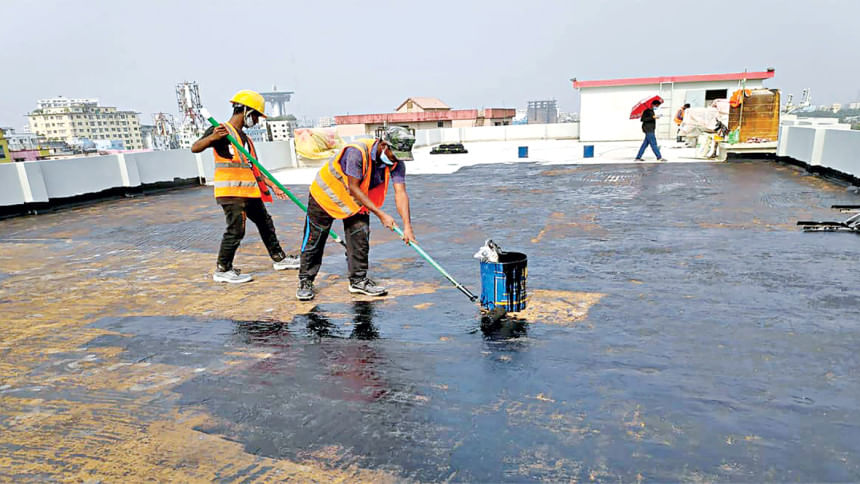Sealing the skies

In Dhaka's rainy season, even a brand-new building can betray its owners. Picture a young family in Gulshan waking up to a steady drip from the ceiling after an evening storm. The damp plaster smell, the fear of mold, and the creeping anxiety about long-term damage. This scene is more common than it should be. Bangladesh's climate of heavy monsoon rains, high humidity, and scorching sun puts rooftops under constant stress. Without proper sealing, roofs fail early, letting water in and problems multiply.
Today, waterproofing is no longer a luxury but a necessity. A good system prevents leaks, extends the roof's life, and protects health indoors. Reflective "cool" coatings add another layer of benefit: they bounce back sunlight, keeping interiors cooler and cutting down electricity use. For larger projects, they even contribute to green building certifications like LEED. In short, a sealed roof doesn't just keep out rain. It improves comfort and long-term value.
Common Waterproofing Solutions
Bangladesh's builders and homeowners rely on a handful of proven options, each with its strengths:
• Cement-based coatings: Applied like plaster, these fill cracks and pores in concrete to block water. They're affordable and easy for terraces or balconies, though they set into a rigid layer.
• Bituminous sheets: Rolled out like thick mats, these create a continuous water barrier. They're tough and suited for large flat roofs but require precise overlapping to work.
• Polyurethane membranes: Liquid coatings that dry into a seamless, rubber-like layer. They stretch to cover cracks and adapt to irregular roofs. They're also UV-resistant, making them a durable choice for Dhaka's climate.
• Acrylic "cool" coats: Bright white finishes that reflect sunlight and resist weathering. They keep interiors cooler while also serving as the waterproofing layer, making them popular for residential terraces.
The right choice depends on the roof's size, slope, and condition. But in every case, success depends less on the material and more on how carefully the surface is prepared and applied. Skipping cleaning, repairs, or priming almost guarantees problems down the line.
Sika Bangladesh: Swiss Tech, Local Roots
Among the leaders in this field is Sika Bangladesh Ltd., a branch of the global Swiss company. Their product line covers all the major systems, from cement coatings to acrylic cool roofs. For homes and commercial buildings alike, their reflective white coatings stand out. They not only stop water but also reduce heat gain, a welcome bonus in Dhaka's summers.
Though Sika mainly serves industrial and commercial projects, it has also begun tackling residential developments. Its local factory in Narayanganj, opened in 2023, produces waterproofing materials specifically for Bangladesh's conditions. This ensures supply is steady and costs remain competitive.
Scale is where Sika shines: it has handled roof areas of up to 100,000 square feet in a single contract. On pricing, their polyurethane systems run about Tk.130 per sq.ft., while cement-based options are in the Tk.70–80 range figures in line with market standards. While that may sound like an extra expense, it's a fraction compared to the cost of repairing water damage or replacing finishes ruined by leaks.
Falcon Solution: Dhaka's Local Expertise
Another trusted name is Falcon Solution Ltd., a Dhaka-based specialist. They often recommend polyurethane or acrylic membranes, especially in white reflective finishes that cool down roof decks. Their technicians focus heavily on inspections and preparation before applying any product.
For example, applying a new coat over a silicone or greasy surface is a recipe for failure. Falcon stresses cleaning, repairing cracks, and priming before sealing. Their approach is straightforward: start with a pressure wash, fix damaged areas, then apply the seamless waterproof coat. The result is a tight, monolithic layer that bonds fully to the roof.
This emphasis on detail sets them apart. A reflective PU or acrylic finish not only keeps out rain but lowers the surface temperature, reducing the building's cooling needs. For a city like Dhaka, where energy use is soaring, this small step can make a noticeable difference.
Why It Matters
For both homeowners and developers, ignoring roof sealing is risky. Leaks don't just stain ceilings; they weaken concrete, corrode reinforcement, and invite mold that affects health. Proper waterproofing is an investment in the building's durability and livability.
This costs roughly Tk.70 to Tk.130 per sq.ft. and is modest compared to the benefits: decades of leak-free protection, cooler interiors, and added property value. With local and international companies offering tailored solutions, access to quality waterproofing has never been easier.
In Bangladesh's climate, sealing the roof offers peace of mind. It means families can sleep through a monsoon storm without buckets on the floor. It means developers deliver buildings that last longer and cost less to maintain. And it means a step toward greener, smarter urban living.

 For all latest news, follow The Daily Star's Google News channel.
For all latest news, follow The Daily Star's Google News channel. 



Comments